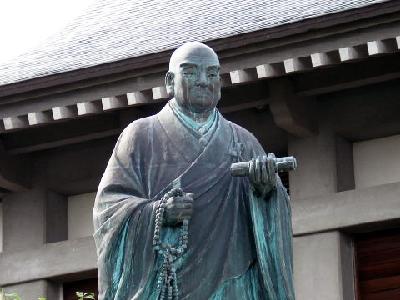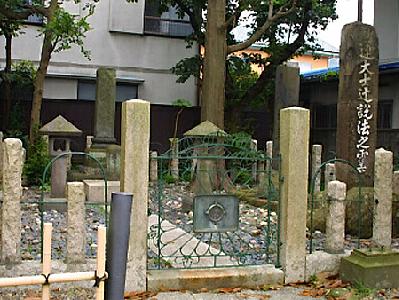|
Nichiren was a Buddhist monk in the Kamakura period (1192-1333) and the founder of the Nichiren sect of Buddhism. Born in Awa province (present-day Chiba Prefecture) in 1222, Nichiren began his Buddhist study at a nearby temple, Seichoji, at the age of 12. He was formally ordained four years later at 16. Then he visited temples in Nara and Kyoto including Shitennoji Temple and Koyasan Kongobuji Temple for more in-depth study. Through the study of Nenbutsu (Buddhist invocation), Zen and Shingon (esoteric practice), he became convinced of the pre-eminence of the Lotus Sutra. In 1253, he founded his own sect of Buddhism at Seichoji Temple and recited “Nam Myoho Renge Kyo” for the first time. He changed his name to Nichiren, wherein the kanji character for nichi (日) means “sun” and that for ren (蓮) means “lotus.”
In 1260, he wrote “the Rissho Ankoku Ron (Treatise on securing the peace of the land through the establishment of the correct),” in which he criticized all the other sects of Japanese Buddhism. It prompted a severe backlash, especially from among priests of other Buddhist sects and the Kamakura Shogunate. Nichiren was harassed and exiled four times in his life. When he was exiled to Sado, an island in the Japan Sea, he wrote two of his most important doctrinal treatises, “the Kaimoku Sho (On the opening of the eyes)” and “the Kanjin no Honzon Sho (The object of devotion for observing the mind in the fifth five-hundred year period).” It was also during his exile on Sado, in 1272, that he inscribed the first Gohonzon, the mandala that he intended as a graphic representation of the essence of the Lotus Sutra.
Nichiren spent the rest of his life at Minobu, where he and his disciples erected Kuonji Temple and he continued writing and training his disciples. In 1282, Nichiren died in Edo (present-day Tokyo). The Japanese imperial court awarded Nichiren the honorific designations “Nichiren Daibosatsu (Great Bodhisattva Nichiren)” in 1358 and “Rissho Daishi (Great Teacher Rissho) in 1922.
In 1260, he wrote “the Rissho Ankoku Ron (Treatise on securing the peace of the land through the establishment of the correct),” in which he criticized all the other sects of Japanese Buddhism. It prompted a severe backlash, especially from among priests of other Buddhist sects and the Kamakura Shogunate. Nichiren was harassed and exiled four times in his life. When he was exiled to Sado, an island in the Japan Sea, he wrote two of his most important doctrinal treatises, “the Kaimoku Sho (On the opening of the eyes)” and “the Kanjin no Honzon Sho (The object of devotion for observing the mind in the fifth five-hundred year period).” It was also during his exile on Sado, in 1272, that he inscribed the first Gohonzon, the mandala that he intended as a graphic representation of the essence of the Lotus Sutra.
Nichiren spent the rest of his life at Minobu, where he and his disciples erected Kuonji Temple and he continued writing and training his disciples. In 1282, Nichiren died in Edo (present-day Tokyo). The Japanese imperial court awarded Nichiren the honorific designations “Nichiren Daibosatsu (Great Bodhisattva Nichiren)” in 1358 and “Rissho Daishi (Great Teacher Rissho) in 1922.
| [+ADDRESS] | 
|














